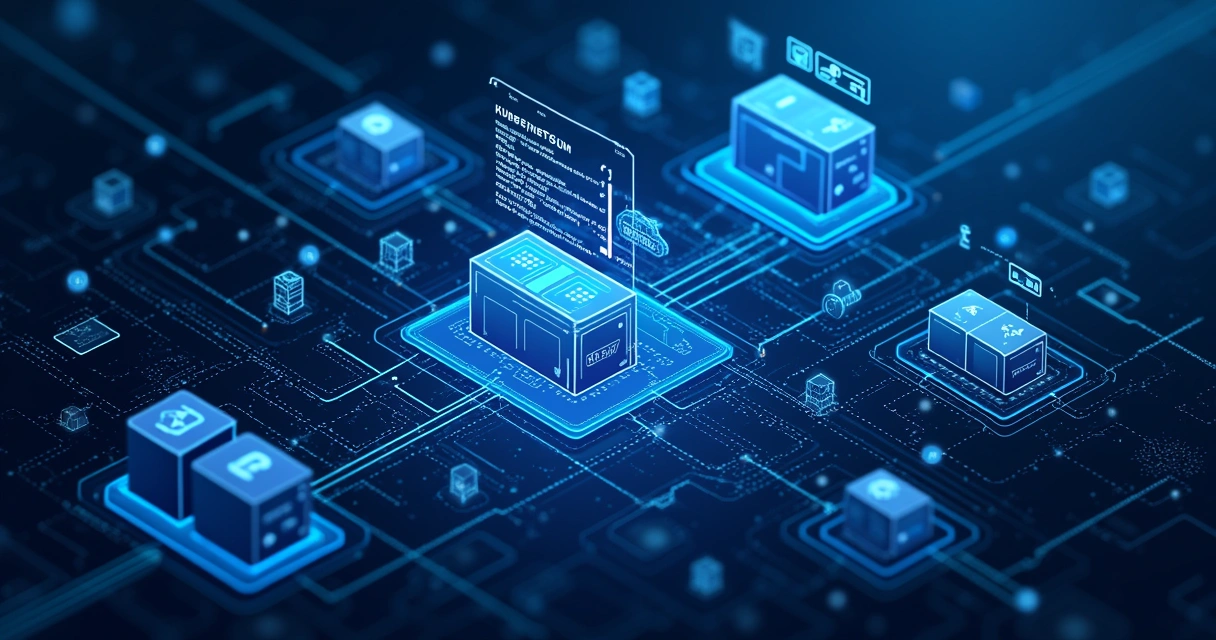People talk a lot about what Kubernetes can do. The documentation covers almost every base. Blogs echo the standard features like pods, services, and deployments.
Once, late at night after yet another failed rollout, I stumbled onto something neat. I realized Kubernetes isn’t just a container orchestrator—it’s a toolkit, built with hidden drawers and secret compartments. Many of these, you won’t discover unless you’re poking around the corners, running a cluster under load, or reading field notes from someone who’s done it all before.
If you’re building robust systems, working with cloud, pushing AI into production, or just obsessive about seeing how far Kubernetes can stretch, these eight features might just change how you see your clusters.
API aggregation: extending the API without rebuilding
You know how we’re always told to “extend, not hack” when workflows get tricky? For most of us, CRDs (Custom Resource Definitions) are old news. But there’s a lesser-known feature: API Aggregation.
With API Aggregation, you can bolt on entirely new APIs to Kubernetes. Not just resources, but whole endpoints, coexisting alongside native ones. It isn’t only for integrating third-party tools or writing elaborate controllers; it’s for inventing your own rules while keeping the whole system’s stability.
The best part? This lets you create API servers that handle specific domains—for example, your internal billing or a custom queue—and access them as you would “kubectl get billing”. Forget hacking components; think smooth extensions that look and feel like Kubernetes itself.
Ephemeral containers: a new debugging friend
There’s a wild moment the first time you try to debug a broken pod—and realize you can’t exec in because the container never started. Ephemeral Containers are the solution you never knew you had.
Unlike normal containers, ephemeral containers don’t run as part of your workload. Instead, as Gilad Trachtenberg explains, you can attach one to any live pod for investigation. No need to redeploy or change your YAML. Just spin up a troubleshooting shell, poke around, then delete when done.
Debug, then disappear. No footprint left.
I’ve used it when nothing else works. It’s still marked as ‘alpha,’ but that’s Kubernetes—sometimes the most useful things hide behind a flag.
Horizontal pod autoscaling with custom metrics
Horizontal Pod Autoscaling (HPA) gets all the attention for scaling based on CPU and memory. But here’s another layer: custom metrics.
With HPA Custom Metrics, you’re no longer tied to infrastructure signals. You can scale on anything: HTTP request rate, queue depth, or even the number of messages in a Kafka topic.
- Expose custom app metrics through a sidecar or adapter.
- Connect these to the Kubernetes Metrics API via Prometheus or another provider.
- Write HPA specs that react to your real bottlenecks—business transactions, AI inference requests, or whatever matters most.
Once you get this running, your clusters can react to real workload demand, not just how hot the CPUs run. This is especially handy when integrating advanced AI models where latency and request surges aren’t predictable by plain resource metrics.
NamespaceAutoprovision admission controller: zero friction namespaces
Namespaces are a foundation. But have you ever hit an error because you referenced a namespace that didn’t exist—just because you mistyped a name? Typically, you’d go create it, then rerun your resource creation. But NamespaceAutoProvision cuts that cycle.
According to Saifeddine Rajhi, the NamespaceAutoProvision Admission Controller watches for the creation of objects in non-existent namespaces, then spins up that namespace automatically—no extra permissions, no manual step. It feels a bit magical (and perhaps risky if you’re messy with names), but in fast-moving CI/CD workflows it cuts friction.
Reference it. If it’s missing, Kubernetes creates it.
Of course, you still need cluster-admin or admission controller setup, but when you want fast, ephemeral environments or self-service teams, this saves headaches.
Pod disruption budgets: graceful changes
Rolling updates sound safe—until you realize one ill-timed update can drain all your pods at once. That’s where Pod Disruption Budgets (PDBs) come in.
- PDBs set a minimum (or maximum) number of replicas that must stay healthy during disruptions—planned or accidental.
- This means node drains, upgrades, or voluntary evictions won’t trash your availability.
It’s strange, but I’ve seen teams running production clusters, scaling to dozens of nodes, not using PDBs even once. Maybe it’s because the feature feels hidden until you hit a sharp outage. If you’re pushing toward robust architectures like we show —especially for stateful systems or anything with end-user access—this small object might be your biggest safeguard.
Debug containers: not just ephemeral, but tailored
Ephemeral Containers help, but debug containers go deeper. Think: containers with extra tools, custom builds, or extra volume mounts, ready for in-depth troubleshooting.
Often bundled in as part of your pod spec but only started when you need them. You can keep your production image trim and safe, but still have a Swiss Army Knife waiting in the wings. This works well for those moments when you want tools that aren’t in your main image, like tcpdump, netcat, or something even more obscure.
Resource quotas and limit ranges: silent cluster protectors
Resource Quotas and Limit Ranges are two features that almost always arrive late—usually after someone OOMs (Out of Memory) the cluster. By defining what teams or users (within namespaces) can consume, you gain not only control, but also clearer tenancy.
- Resource Quotas police how much CPU, memory, storage, or even objects a namespace can use.
- Limit Ranges set min and max resources per pod or container, so no runaway app eats the farm.
The best admins set them from the start. Everyone else, well—they learn fast.
 Machine learning workloads: Kubernetes as the backbone
Machine learning workloads: Kubernetes as the backbone
Kubernetes is often billed as the answer to web scalability, but it hides a lot of power for running machine learning workloads too. According to Softweb Solutions, teams use Kubernetes for complex training batches, GPU scheduling, and multi-cloud model serving.
Automatic resource allocation and high availability mean you can take ML models from a laptop prototype to distributed, robust deployment. Whether it’s a batch job or real-time inference, Kubernetes can help ML stay stable—and even allow canary testing or blue/green deployments of your models.
Conclusion: small details, big shifts
Lots of people use Kubernetes in predictable ways. The best clusters aren’t those with the fanciest infrastructure—they’re the ones where someone knew to flip the right switch, or set the right flag, at the right time. Sometimes, those switches change how robust, safe, or innovative your systems can really be.
Hidden features aren’t just trivia—they’re survival tools.
If you care about robust back-end design, real-world architecture, or bridging AI and cloud, these features will help—not just because they exist, but because they were built by people who faced the same headaches you do.
So—explore, experiment, question defaults. And if you want more of these field-tested insights, check out our guides and join the Arthur Raposo community. We’re building something here, and we want critical minds like yours with us.
Frequently asked questions about hidden Kubernetes features
What are hidden features in Kubernetes?
Hidden features in Kubernetes are those not featured in basic tutorials or production checklists—like ephemeral containers for debugging, API Aggregation for adding new endpoints, or namespace auto-provisioning for smoother workflows. These features sometimes appear as alpha or beta, or are simply less well-documented. The best way to discover them is by working through real-world Kubernetes issues and reading guides from practitioners.
How to enable hidden Kubernetes features?
Some hidden features are already present but disabled by default (like ephemeral containers or certain admission controllers). You can enable them by toggling feature gates in your Kubernetes API server or kubelet, or by editing the configuration for controllers and CRDs. Always check the documentation for your Kubernetes version to know what’s available and stable.
Are hidden Kubernetes features stable to use?
It depends. Some hidden features are marked as ‘beta’ or ‘alpha’—meaning they might change or even disappear in future versions. Features in ‘GA’ (generally available) status are considered stable. For experimental features, it’s best to use them in non-production environments first and monitor for changes in upcoming Kubernetes releases.
Where to find more Kubernetes secrets?
Great sources include the official Kubernetes Enhancement Proposals (KEPs), blogs by Kubernetes maintainers, and field guides from technical communities like Arthur Raposo. Medium, GitHub discussions, and talks from past KubeCons are full of ‘battle scars’ and deeper practical insights than formal docs cover.



 Machine learning workloads: Kubernetes as the backbone
Machine learning workloads: Kubernetes as the backbone
Leave A Comment